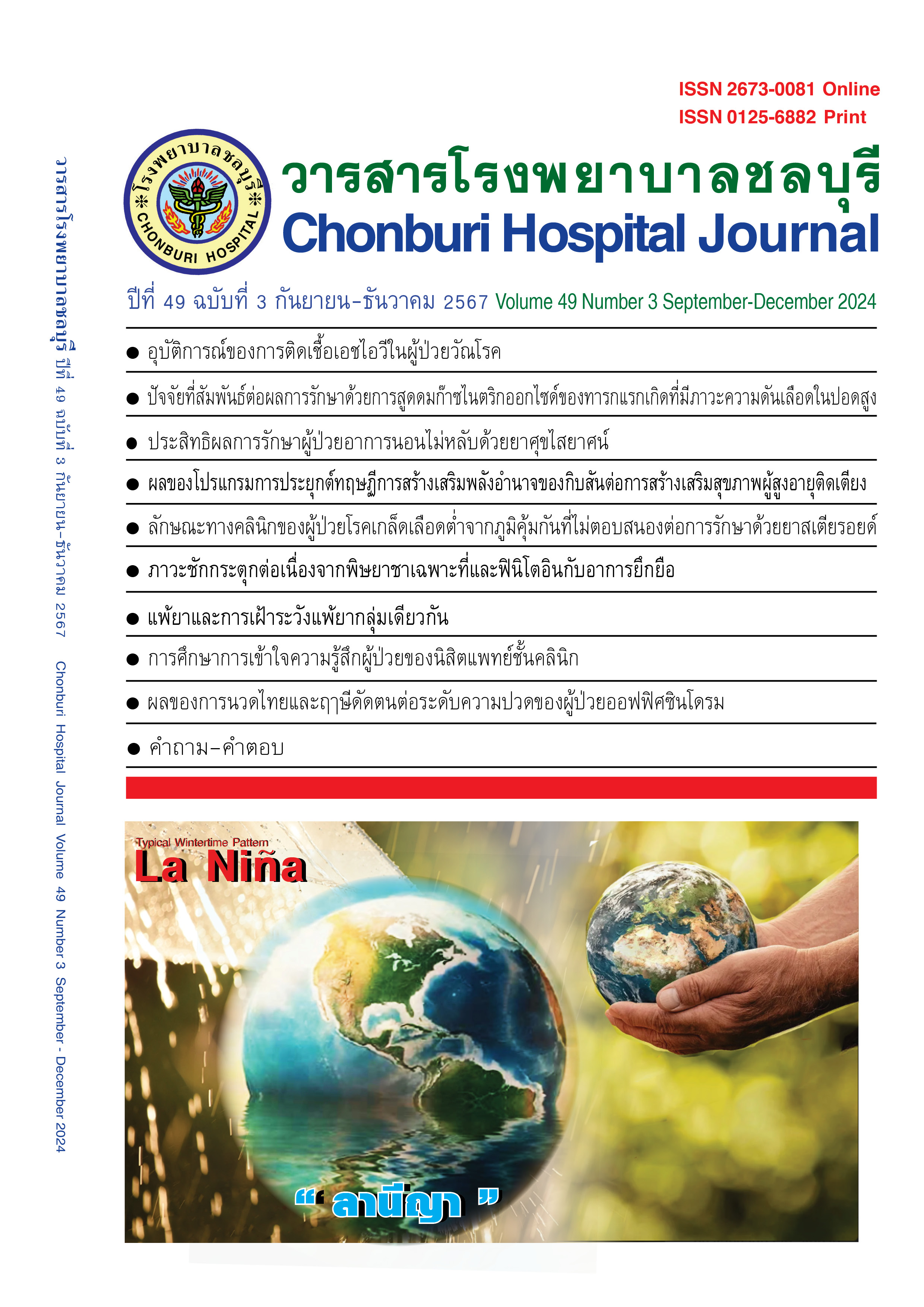The Status Epilepticus following Local Anesthetic Toxicity and Phenytoin induced Dyskinesia: A Case Report
Abstract
Phenytoin is effective antiseizure medication which frequently prescribed in clinical practice. Involuntary movements are a less familiar complication of treatment with phenytoin and include tremor, asterixis, myoclonus and tardive dyskinesia. A case report of 6-year-old boy was refered from private hospital with history of accidental falling and he had lacerated wound at both forearm from stone cuts and during stitched suture at emergency room he had developed symptoms of convulsive status epilepticus. He received diazepam 5 mg intravenous 2 doses (0.3 mg/kg) and loading dose of phenytoin 400 mg (21.6 mg/kg) intravenous and stop seizure. He was unconscious and need intubated. He was refered to Chonburi hospital and was given maintenance dose 5 mg/kg/day intravenous of phenytoin. The second day of admission he was noted to have abnormal movement as tardive dyskinesia consisting of facial grimacing, tongue protrusion, eyebrow elevation and limbs dyskinesia. General and neurological examination were normal. Blood test and cerebrospinal fluid exam were normal. We reviewed history of patient’s treatment and all drugs usage and found that he was injected 2% lidocaine amount of 10 cc or 200 mg (10.8 mg/kg) for local anesthesia during stitched wounds, his body weight 18.5 kg which over than toxic dose of Lidocain is 4.5 mg/kg. Conclusion that lidocaine toxicity caused convulsive statue epilepticus and phenytoin was immediately discontinued. The tardive dyskinesia resolved after withdrawal of phenytoin. The patient returned to normal in the third day of admission.
Keywords : Local anesthetic toxicity, status epilepticus, Phenytoin-Anticonvulsants, Tardive dyskinesia
References
Patocka J, Wu Q, Nepovimova E, Kuca KJF, Toxicology C. Phenytoin and antiseizure drug: overview of its chemistry, pharmacology and toxicology. FoodChem Toxicol. 2020;142:111-393.
Rissardo JP, Caprara ALF. Phenytoin-associated movement disorder: a literature review. Tzu Chi Medical Journal. 2022;34(4):409-17.
Rosenblum E, Rodichom L, Hanson PA. Movement disorder as a manifestation of diphenylhydantoin toxicity. Pediatrics. 1974;24:68-71.
Jan JE, Kliman MR. Extrapyramidal disturbance and vascular changes during diphenylhydantoin intoxication. Can Med Assoc J. 1974;111:636-41.
Opida CL, Kothals JK, Somasundaram M. Bilateral ballismus in phenytoin intoxication. Ann Neurol. 1978;3:186.
Buchanan N, Rosen E, Rabinowitz L. Athetosis and phenytoin toxicity. Am J Dis Child. 1977;131:105.
DeVeaugh-Geiss J. Aggravation of tardive dyskinesia by phenytoin. N Engl J Med. 1978;298:457-8.
Corey A, Koller W. Phenytoin-induced dystonia. Ann Neurol. 1983;14:92–3.
Choonara IA, Rosenbloom L. Focal dystonic reaction to phenytoin. Dev Med Child Neurol. 1984;26:677–8.
Chaudhary N, Ravat SH, Shah PU. Phenytoin induced dyskinesia. Indian Pediatr. 1998;35:274–6.
Reynolds EH, Trimble MR. Adverse neuropsychiatric effects of anti- convulsant drugs. Drugs. 1985;29:570–81.
Yamamoto K, Noda S, Itou H, Umezaki H, Morimatsu M. A case of involuntary movements probably produced by low doses of phenytoin intoxication. Rinsho Shinkeigaku. 1990;30:571–3.
Hoaken PC, Kane FJ. Unusual brain syndrome seen with diphenylhydantoin and pentobarbital. Am J Psychiatry. 1963;120:282-3.
Peters HA, Eichman PL, Price JM, Kozelka FL, Reese HH. Abnormal copper and tryptophan metabolism and chelation therapy in anticonvulsant drug intolerance. Dis Nerv Syst. 1966;27:97-107.
Shulman L, Singer C, Weiner W. Phenytoin-induced focal chorea. Mov Disord. 1996;11:111-4.
Sekimoto K, Tobe M, Saito S. Local anesthetic toxicity: acute and chronic management. Acute Med Surg. 2017 Apr;4(2):152-60.
Yoshida M, Yamada S, Ozaki Y, Nakanishi T. Phenytoin-induced orofacial dyskinesia: a case report. J Neurol. 1985;231:340–2.
Harrison M, Lyons G, Landow E. Phenytoin and dyskinesias: a report of two cases and review of the literature. Mov Disord. 1993;8(1):19–27.
Montenegro MA, Scotoni AE, Cendes F. Dyskinesia induced by phenytoin. Arq Neuropsiquiatr. 1999;57:356-60.
Micheli F, Lehkuniec E, Gatto M, Pelli M, Asconape J. Hemiballimus in a patient with partial motor status epilepticus treated with phenytoin. Funct Neurol. 1993;8:103-7.
Garcia-Ramos R, Ramos TM, Galende AV, Etessam JPJN. Phenytoin-induced acute orofacial dyskinesia. Neurologia. 2013;28(3):193-4.
Donald MJ, Derbyshire S. Lignocaine toxicity; a complication of local anaesthesia administered in the community. Emerg Med J. 2004;21:249-50.
Moran LR, Hossain T, Insoft RM. Neonatal seizures following lidocaine administration for elective circumcision. J Perinatol. 2004;24:395-6.
Downloads
Published
Issue
Section
License

This work is licensed under a Creative Commons Attribution-NonCommercial-NoDerivatives 4.0 International License.
บทความที่ได้รับการตีพิมพิ์เป็นลิขสิทธิ์ของวารสารโรงพยาบาลชลบุรี
